

Compact Muon Solenoid
LHC, CERN
| CMS-EXO-16-046 ; CERN-EP-2018-036 | ||
| Search for new physics in dijet angular distributions using proton-proton collisions at $\sqrt{s} = $ 13 TeV and constraints on dark matter and other models | ||
| CMS Collaboration | ||
| 21 March 2018 | ||
| Eur. Phys. J. C 78 (2018) 789 | ||
| Abstract: A search is presented for physics beyond the standard model, based on measurements of dijet angular distributions in proton-proton collisions at $\sqrt{s} = $ 13 TeV. The data collected with the CMS detector at the LHC correspond to an integrated luminosity of 35.9 fb$^{-1}$. The observed distributions, corrected to particle level, are found to be in agreement with predictions from perturbative quantum chromodynamics that include electroweak corrections. Constraints are placed on models containing quark contact interactions, extra spatial dimensions, quantum black holes, or dark matter, using the detector-level distributions. In a benchmark model where only left-handed quarks participate, contact interactions are excluded at the 95% confidence level up to a scale of 12.8 or 17.5 TeV, for destructive or constructive interference, respectively. The most stringent lower limits to date are set on the ultraviolet cutoff in the Arkani-Hamed-Dimopoulos-Dvali model of extra dimensions. In the Giudice-Rattazzi-Wells convention, the cutoff scale is excluded up to 10.1 TeV. The production of quantum black holes is excluded for masses below 5.9 and 8.2 TeV, depending on the model. For the first time, lower limits between 2.0 and 4.6 TeV are set on the mass of a dark matter mediator for (axial-)vector mediators, for the universal quark coupling ${g_{\mathrm{q}}} =$ 1.0. | ||
| Links: e-print arXiv:1803.08030 [hep-ex] (PDF) ; CDS record ; inSPIRE record ; HepData record ; CADI line (restricted) ; | ||
| Figures | |
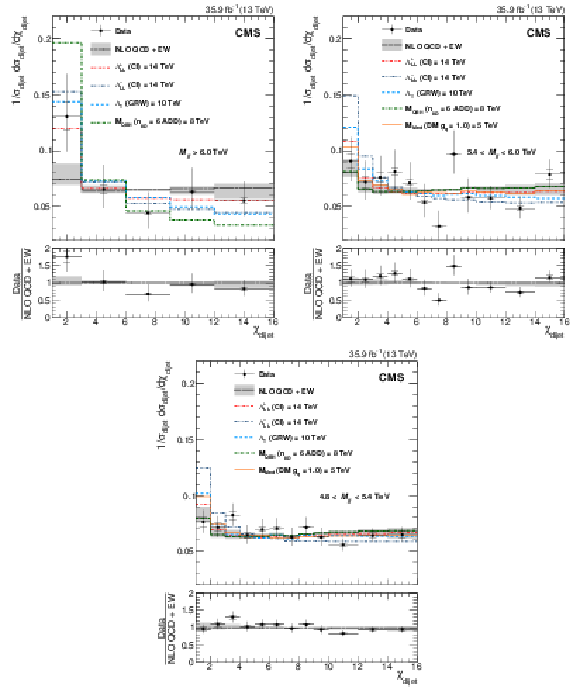
png pdf |
Figure 1:
Normalized $ {\chi _{\text {dijet}}} $ distributions in the three highest mass bins. Unfolded data are compared to NLO predictions (black dotted line). The error bars represent statistical and experimental systematic uncertainties combined in quadrature. The ticks on the error bars correspond to the experimental systematic uncertainties only. Theoretical uncertainties are indicated as a gray band. Also shown are the predictions for various CI, ADD, QBH, and DM scenarios. The lower panels show the ratio of the unfolded data distributions and NLO predictions. |

png pdf |
Figure 1-a:
Normalized $ {\chi _{\text {dijet}}} $ distribution in mass bin $ M_{jj} > $ 6.6 TeV. Unfolded data are compared to NLO predictions (black dotted line). The error bars represent statistical and experimental systematic uncertainties combined in quadrature. The ticks on the error bars correspond to the experimental systematic uncertainties only. Theoretical uncertainties are indicated as a gray band. Also shown are the predictions for various CI, ADD, QBH, and DM scenarios. The lower panel shows the ratio of the unfolded data distributions and NLO predictions. |
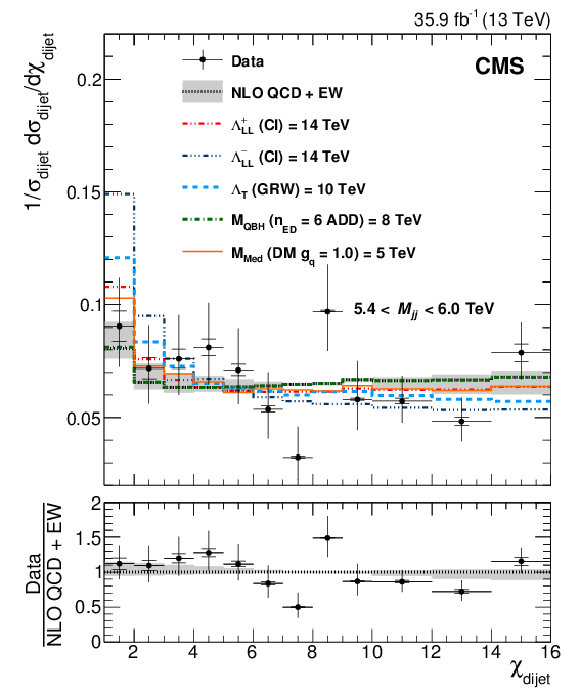
png pdf |
Figure 1-b:
Normalized $ {\chi _{\text {dijet}}} $ distribution in mass bin 5.4 $ < M_{jj} < $ 6.6 TeV. Unfolded data are compared to NLO predictions (black dotted line). The error bars represent statistical and experimental systematic uncertainties combined in quadrature. The ticks on the error bars correspond to the experimental systematic uncertainties only. Theoretical uncertainties are indicated as a gray band. Also shown are the predictions for various CI, ADD, QBH, and DM scenarios. The lower panel shows the ratio of the unfolded data distributions and NLO predictions. |
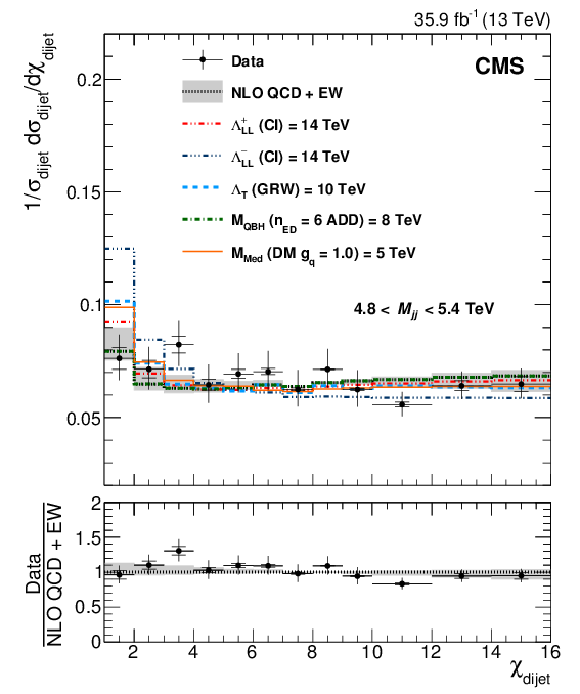
png pdf |
Figure 1-c:
Normalized $ {\chi _{\text {dijet}}} $ distribution in mass bin 4.8 $ < M_{jj} < $ 5.4 TeV. Unfolded data are compared to NLO predictions (black dotted line). The error bars represent statistical and experimental systematic uncertainties combined in quadrature. The ticks on the error bars correspond to the experimental systematic uncertainties only. Theoretical uncertainties are indicated as a gray band. Also shown are the predictions for various CI, ADD, QBH, and DM scenarios. The lower panel shows the ratio of the unfolded data distributions and NLO predictions. |
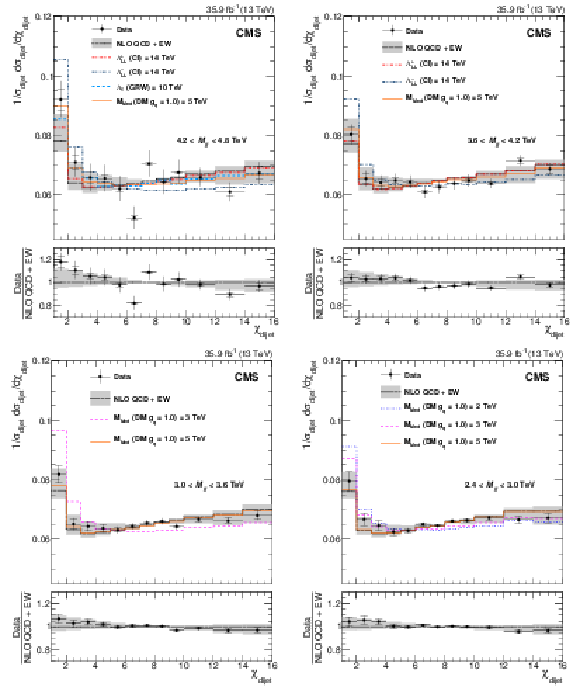
png pdf |
Figure 2:
Normalized $ {\chi _{\text {dijet}}} $ distributions in the four lower mass bins. Unfolded data are compared to NLO predictions (black dotted line). The error bars represent statistical and experimental systematic uncertainties combined in quadrature. The ticks on the error bars correspond to the experimental systematic uncertainties only. Theoretical uncertainties are indicated as a gray band. Also shown are the predictions for various CI, ADD, and DM scenarios. The lower panels show the ratio of the unfolded data distributions and NLO predictions. |
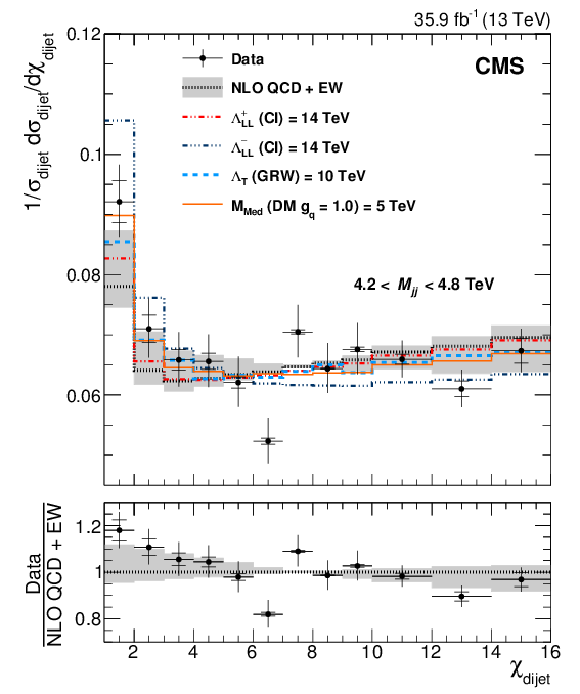
png pdf |
Figure 2-a:
Normalized $ {\chi _{\text {dijet}}} $ distribution in mass bin 4.2 $ < M_{jj} < $ 4.8 TeV. Unfolded data are compared to NLO predictions (black dotted line). The error bars represent statistical and experimental systematic uncertainties combined in quadrature. The ticks on the error bars correspond to the experimental systematic uncertainties only. Theoretical uncertainties are indicated as a gray band. Also shown are the predictions for various CI, ADD, and DM scenarios. The lower panel shows the ratio of the unfolded data distributions and NLO predictions. |

png pdf |
Figure 2-b:
Normalized $ {\chi _{\text {dijet}}} $ distribution in mass bin 3.6 $ < M_{jj} < $ 4.2 TeV. Unfolded data are compared to NLO predictions (black dotted line). The error bars represent statistical and experimental systematic uncertainties combined in quadrature. The ticks on the error bars correspond to the experimental systematic uncertainties only. Theoretical uncertainties are indicated as a gray band. Also shown are the predictions for various CI, ADD, and DM scenarios. The lower panel shows the ratio of the unfolded data distributions and NLO predictions. |
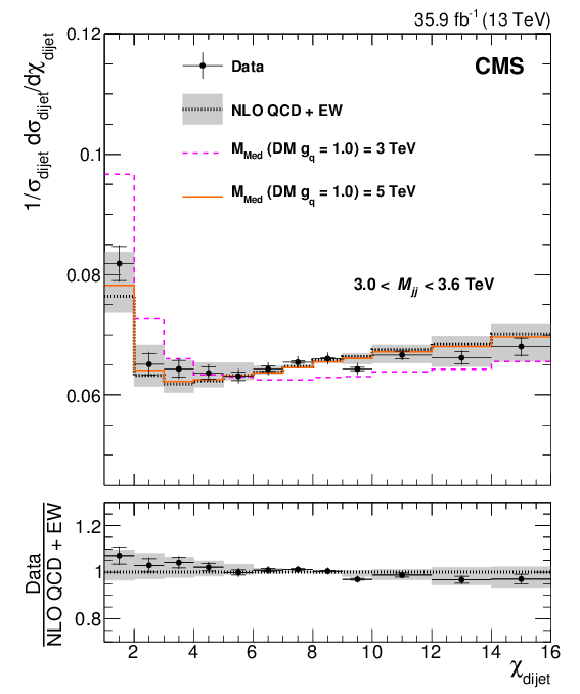
png pdf |
Figure 2-c:
Normalized $ {\chi _{\text {dijet}}} $ distribution in mass bin 3.0 $ < M_{jj} < $ 3.6 TeV. Unfolded data are compared to NLO predictions (black dotted line). The error bars represent statistical and experimental systematic uncertainties combined in quadrature. The ticks on the error bars correspond to the experimental systematic uncertainties only. Theoretical uncertainties are indicated as a gray band. Also shown are the predictions for various CI, ADD, and DM scenarios. The lower panel shows the ratio of the unfolded data distributions and NLO predictions. |

png pdf |
Figure 2-d:
Normalized $ {\chi _{\text {dijet}}} $ distribution in mass bin 2.4 $ < M_{jj} < $ 3.0 TeV. Unfolded data are compared to NLO predictions (black dotted line). The error bars represent statistical and experimental systematic uncertainties combined in quadrature. The ticks on the error bars correspond to the experimental systematic uncertainties only. Theoretical uncertainties are indicated as a gray band. Also shown are the predictions for various CI, ADD, and DM scenarios. The lower panel shows the ratio of the unfolded data distributions and NLO predictions. |

png pdf |
Figure 3:
The 95% CL upper limits on the quark coupling $ {g_{\mathrm {\mathrm{q}}}} $, as a function of mass, for an axial-vector or vector DM mediator with $ {g_{\mathrm {DM}}} = $ 1.0 and $ {m_{\mathrm {DM}}} = $ 1 GeV. The observed limits (solid), expected limits (dashed) and the variation in the expected limit at the 1 and 2 standard deviation levels (shaded bands) are shown. A dotted horizontal line shows the coupling strength for a benchmark DM mediator with $ {g_{\mathrm {{\mathrm {q}}}}} = $ 1.0. The corresponding limits on the width of the mediators are shown on the vertical axis on the right-hand side of the figure. |
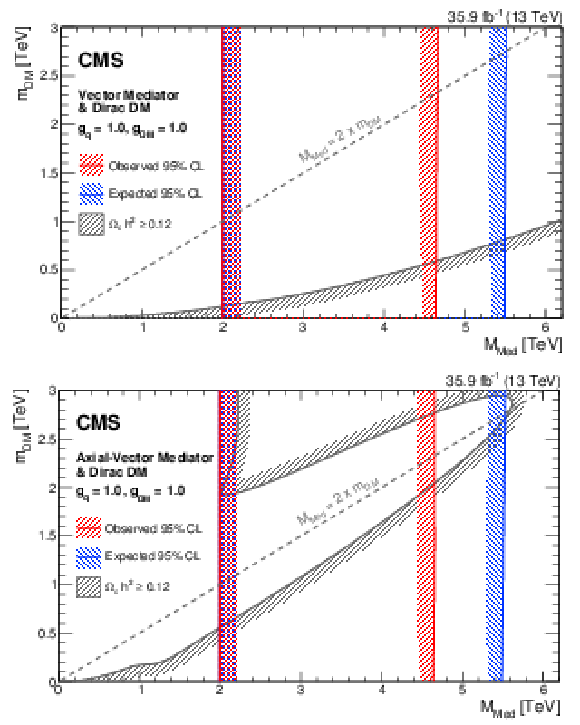
png pdf |
Figure 4:
The 95% CL observed (red) and expected (blue) excluded regions in the plane of ${m_{\mathrm {DM}}}$ and ${M_{\text {Med}}}$, for a vector mediator (upper) and an axial-vector mediator (lower) for a DM benchmark model with $ {g_{\mathrm {DM}}} = {g_{\mathrm {\mathrm{q}}}} =$ 1.0. These are compared to constraints from the cosmological relic density of DM (gray) determined from astrophysical measurements [79], using {MadDM}. In the hatched area, DM is overabundant. The observed and expected lower bounds for ${M_{\text {Med}}}$ overlap with each other. |
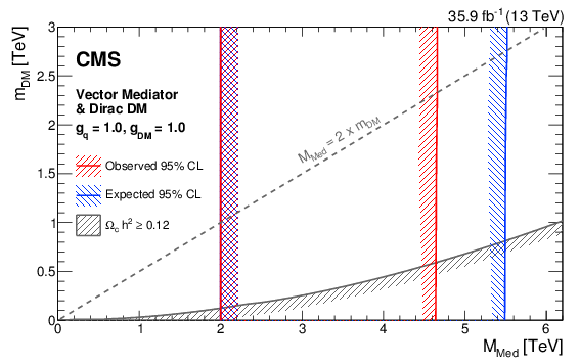
png pdf |
Figure 4-a:
The 95% CL observed (red) and expected (blue) excluded regions in the plane of ${m_{\mathrm {DM}}}$ and ${M_{\text {Med}}}$, for a vector mediator for a DM benchmark model with $ {g_{\mathrm {DM}}} = {g_{\mathrm {\mathrm{q}}}} =$ 1.0. These are compared to constraints from the cosmological relic density of DM (gray) determined from astrophysical measurements [79], using {MadDM}. In the hatched area, DM is overabundant. The observed and expected lower bounds for ${M_{\text {Med}}}$ overlap with each other. |
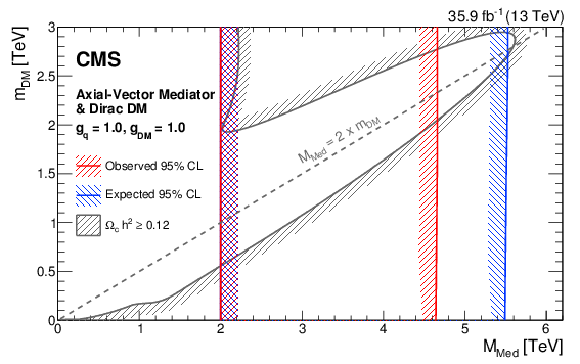
png pdf |
Figure 4-b:
The 95% CL observed (red) and expected (blue) excluded regions in the plane of ${m_{\mathrm {DM}}}$ and ${M_{\text {Med}}}$, for a axial-vector mediator for a DM benchmark model with $ {g_{\mathrm {DM}}} = {g_{\mathrm {\mathrm{q}}}} =$ 1.0. These are compared to constraints from the cosmological relic density of DM (gray) determined from astrophysical measurements [79], using {MadDM}. In the hatched area, DM is overabundant. The observed and expected lower bounds for ${M_{\text {Med}}}$ overlap with each other. |
| Tables | |

png pdf |
Table 1:
Summary of the leading experimental and theoretical uncertainties in the normalized $ {\chi _{\text {dijet}}} $ distributions, in percent. While the statistical analysis represents each uncertainty through a change in the $ {\chi _{\text {dijet}}} $ distribution correlated among all $ {\chi _{\text {dijet}}} $ bins, this table summarizes each uncertainty by a representative value to show their relative contributions. For the lowest and highest dijet mass bins, the relative shift is given for the lowest $ {\chi _{\text {dijet}}} $ bin. In the highest dijet mass bin, the dominant experimental contribution corresponds to the statistical uncertainty, while the dominant theoretical contribution is from the uncertainty in scales. |
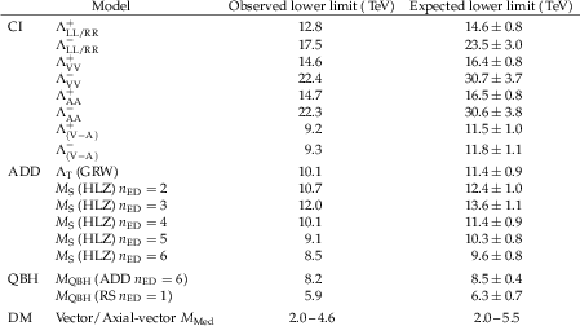
png pdf |
Table 2:
Observed and expected exclusion limits at 95% CL for various CI, ADD, QBH, and DM models. The 68% ranges of expectation for the expected limit are given as well. For the DM vector mediator, couplings $ {g_{\mathrm {DM}}} =$ 1.0, $ {g_{\mathrm {\mathrm{q}}}} \geq $ 1 and a DM mass of 1 GeV are assumed and a range of masses instead of a lower limit is quoted. |
| Summary |
| A search has been presented for physics beyond the standard model, based on normalized dijet angular distributions obtained in 2016 from proton-proton collisions at the LHC. The data sample corresponds to an integrated luminosity of 35.9 fb$^{-1}$. The angular distributions, measured over a wide range of dijet invariant masses, are found to be in agreement with the predictions of perturbative quantum chromodynamics. The results are used to set 95% confidence level lower limits on the contact interaction scale for a variety of quark compositeness models, the ultraviolet cutoff in models of extra spatial dimensions, the minimum mass of quantum black holes, and the mass and couplings in dark matter models. For the first time, lower limits between 2.0 and 4.6 TeV are set on the mass of a dark matter mediator for (axial-)vector mediators, for the universal quark coupling ${g_{\mathrm{q}}} \geq $ 1. This region is not accessible through dijet resonance searches. The lower limits for the contact interaction scale $\Lambda$ range from 9.2 to 22.4 TeV. The lower limits on the ultraviolet cutoff in the Arkani-Hamed-Dimopoulos-Dvali model are in the range of 8.5-12 TeV, and are the most stringent limits available. Quantum black hole masses below 8.2 TeV are excluded in the model with six large extra spatial dimensions, and below 5.9 TeV in the Randall-Sundrum model with a single, warped extra dimension. To facilitate comparisons with the predictions of other models, the angular distributions, corrected to particle level, are published in HEPData. |
| References | ||||
| 1 | H. Dreiner, D. Schmeier, and J. Tattersall | Contact interactions probe effective dark matter models at the LHC | Europhys. Lett. 102 (2013) 51001 | 1303.3348 |
| 2 | J. Abdallah et al. | Simplified models for dark matter searches at the LHC | Phys. Dark Univ. 9-10 (2015) 8 | 1506.03116 |
| 3 | G. Busoni et al. | Recommendations on presenting LHC searches for missing transverse energy signals using simplified $ s $-channel models of dark matter | 1603.04156 | |
| 4 | A. Albert et al. | Recommendations of the LHC Dark Matter Working Group: Comparing LHC searches for heavy mediators of dark matter production in visible and invisible decay channels | 1703.05703 | |
| 5 | D. Abercrombie et al. | Dark Matter Benchmark Models for Early LHC Run-2 Searches: Report of the ATLAS/CMS Dark Matter Forum | 1507.00966 | |
| 6 | H. Terazawa | Subquark model of leptons and quarks | PRD 22 (1980) 184 | |
| 7 | E. Eichten, K. Lane, and M. Peskin | New tests for quark and lepton substructure | PRL 50 (1983) 811 | |
| 8 | E. Eichten, I. Hinchliffe, K. Lane, and C. Quigg | Supercollider physics | Rev. Mod. Phys. 56 (1984) 579 | |
| 9 | N. Arkani-Hamed, S. Dimopoulos, and G. Dvali | The hierarchy problem and new dimensions at a millimeter | PLB 429 (1998) 263 | hep-ph/9803315 |
| 10 | N. Arkani-Hamed, S. Dimopoulos, and G. Dvali | Phenomenology, astrophysics and cosmology of theories with sub-millimeter dimensions and TeV scale quantum gravity | PRD 59 (1999) 086004 | hep-ph/9807344 |
| 11 | P. C. Argyres, S. Dimopoulos and J. March-Russell | Black holes and sub-millimeter dimensions | PLB 441 (1998) 96 | hep-th/9808138 |
| 12 | T. Banks and W. Fischler | A model for high-energy scattering in quantum gravity | hep-th/9906038 | |
| 13 | R. Emparan, G. T. Horowitz, and R. C. Myers | Black holes radiate mainly on the brane | PRL 85 (2000) 499 | hep-th/0003118 |
| 14 | S. Dimopoulos and G. Landsberg | Black holes at the LHC | PRL 87 (2001) 161602 | hep-ph/0106295 |
| 15 | S. B. Giddings and S. Thomas | High energy colliders as black hole factories: the end of short distance physics | PRD 65 (2002) 056010 | hep-ph/0106219 |
| 16 | M. Chala et al. | Constraining dark sectors with monojets and dijets | JHEP 07 (2015) 089 | 1503.05916 |
| 17 | ATLAS Collaboration | Search for new phenomena in dijet events using 37 fb$ ^{-1} $ of pp collision data collected at $ \sqrt{s}= $ 13 TeV with the ATLAS detector | PRD 96 (2017) 052004 | 1703.09127 |
| 18 | CMS Collaboration | Search for dijet resonances in proton-proton collisions at $ \sqrt{s} = $ 13 TeV and constraints on dark matter and other models | PLB 769 (2016) 520 | CMS-EXO-16-032 1611.03568 |
| 19 | UA1 Collaboration | Angular distributions for high mass jet pairs and a limit on the energy scale of compositeness for quarks from the CERN $ \mathrm{p\bar{p}} $ collider | PLB 177 (1986) 244 | |
| 20 | B. L. Combridge and C. J. Maxwell | Untangling large $ p_{\text{T}} $ hadronic reactions | NPB 239 (1984) 429 | |
| 21 | ATLAS Collaboration | Search for quark contact interactions in dijet angular distributions in pp collisions at $ \sqrt{s}= $ 7 TeV measured with the ATLAS detector | PLB 694 (2010) 327 | 1009.5069 |
| 22 | ATLAS Collaboration | Search for new physics in dijet mass and angular distributions in pp collisions at $ \sqrt{s}= $ 7 TeV measured with the ATLAS detector | New J. Phys. 13 (2011) 053044 | 1103.3864 |
| 23 | ATLAS Collaboration | ATLAS search for new phenomena in dijet mass and angular distributions using pp collisions at $ \sqrt{s}= $ 7 TeV | JHEP 01 (2013) 029 | 1210.1718 |
| 24 | ATLAS Collaboration | Search for new phenomena in the dijet mass distribution using pp collision data at $ \sqrt{s}= $ 8 TeV with the atlas detector | PRD 91 (2015) 052027 | 1407.1376 |
| 25 | ATLAS Collaboration | Search for new phenomena in dijet mass and angular distributions from pp collisions at $ \sqrt{s}= $ 13 TeV with the ATLAS detector | PLB 754 (2016) 302 | 1512.01530 |
| 26 | CMS Collaboration | Measurement of dijet angular distributions and search for quark compositeness in pp collisions at $ \sqrt{s}= $ 7 TeV | PRL 106 (2011) 201804 | CMS-EXO-10-009 1102.2020 |
| 27 | CMS Collaboration | Search for quark compositeness in dijet angular distributions from pp collisions at $ \sqrt{s}= $ 7 TeV | JHEP 05 (2012) 055 | CMS-EXO-11-017 1202.5535 |
| 28 | CMS Collaboration | Search for quark contact interactions and extra spatial dimensions using dijet angular distributions in proton-proton collisions at $ \sqrt{s}= $ 8 TeV | PLB 746 (2015) 79 | CMS-EXO-12-050 1411.2646 |
| 29 | CMS Collaboration | Search for new physics with dijet angular distributions in proton-proton collisions at $ \sqrt{s}= $ 13 TeV | JHEP 07 (2017) 013 | CMS-EXO-15-009 1703.09986 |
| 30 | Y. Bai, P. J. Fox, and R. Harnik | The Tevatron at the Frontier of Dark Matter Direct Detection | JHEP 12 (2010) 048 | 1005.3797 |
| 31 | I. M. Shoemaker and L. Vecchi | Unitarity and monojet bounds on models for DAMA, CoGeNT, and CRESST-II | PRD 86 (2012) 015023 | 1112.5457 |
| 32 | CMS Collaboration | Search for narrow and broad dijet resonances in proton-proton collisions at $ \sqrt{s}= $ 13 TeV and constraints on dark matter mediators and other new particles | JHEP 08 (2018) 130 | CMS-EXO-16-056 1806.00843 |
| 33 | ATLAS Collaboration | Search for new phenomena in final states with an energetic jet and large missing transverse momentum in pp collisions at $ \sqrt{s}= $ 13 TeV using the ATLAS detector | PRD 94 (2016) 032005 | 1604.07773 |
| 34 | CMS Collaboration | Search for dark matter produced with an energetic jet or a hadronically decaying W or Z boson at $ \sqrt{s} = $ 13 TeV | JHEP 07 (2017) 014 | CMS-EXO-16-037 1703.01651 |
| 35 | CMS Collaboration | Search for new physics in final states with an energetic jet or a hadronically decaying $ W $ or $ Z $ boson and transverse momentum imbalance at $ \sqrt{s}=$ 13 TeV | PRD 97 (2018) 092005 | CMS-EXO-16-048 1712.02345 |
| 36 | CMS Collaboration | Search for contact interactions using the inclusive jet $ p_{\text{T}} $ spectrum in pp collisions at $ \sqrt{s}= $ 7 TeV | PRD 87 (2013) 052017 | CMS-EXO-11-010 1301.5023 |
| 37 | S. W. Hawking | Particle creation by black holes | Commun. Math. Phys. 43 (1975) 199 | |
| 38 | X. Calmet, W. Gong, and S. D. H. Hsu | Colorful quantum black holes at the LHC | PLB 668 (2008) 20 | 0806.4605 |
| 39 | P. Meade and L. Randall | Black holes and quantum gravity at the LHC | JHEP 05 (2008) 003 | 0708.3017 |
| 40 | D. M. Gingrich | Quantum black holes with charge, colour, and spin at the LHC | JPG 37 (2010) 105008 | 0912.0826 |
| 41 | CMS Collaboration | The CMS trigger system | JINST 12 (2017) P01020 | CMS-TRG-12-001 1609.02366 |
| 42 | CMS Collaboration | The CMS experiment at the CERN LHC | JINST 3 (2008) S08004 | CMS-00-001 |
| 43 | CMS Collaboration | Particle-flow reconstruction and global event description with the CMS detector | JINST 12 (2017) P10003 | CMS-PRF-14-001 1706.04965 |
| 44 | M. Cacciari, G. P. Salam, and G. Soyez | The anti-$ {k_{\mathrm{T}}} $ jet clustering algorithm | JHEP 04 (2008) 063 | 0802.1189 |
| 45 | M. Cacciari, G. P. Salam, and G. Soyez | FastJet user manual | EPJC 72 (2012) 1896 | 1111.6097 |
| 46 | CMS Collaboration | Jet algorithms performance in 13 TeV data | CMS-PAS-JME-16-003 | CMS-PAS-JME-16-003 |
| 47 | CMS Collaboration | Jet energy scale and resolution in the CMS experiment in pp collisions at 8 TeV | JINST 12 (2017) P02014 | CMS-JME-13-004 1607.03663 |
| 48 | T. Sjostrand, S. Mrenna, and P. Skands | PYTHIA 6.4 physics and manual | JHEP 05 (2006) 026 | hep-ph/0603175 |
| 49 | T. Sjostrand, S. Mrenna, and P. Skands | A brief introduction to PYTHIA 8.1 | Comput. Phys. Comm. 178 (2008) 852 | 0710.3820 |
| 50 | CMS Collaboration | CMS luminosity measurements for the 2016 data taking period | CMS-PAS-LUM-17-001 | CMS-PAS-LUM-17-001 |
| 51 | M. J. Oreglia | A study of the reactions $\psi' \to \gamma\gamma \psi$ | PhD thesis, Stanford University, 1980 SLAC Report SLAC-R-236, see A | |
| 52 | T. Adye | Unfolding algorithms and tests using RooUnfold | in Proceedings, PHYSTAT 2011 Workshop on Statistical Issues Related to Discovery Claims in Search Experiments and Unfolding, CERN 2011 | 1105.1160 |
| 53 | G. D'Agostini | A multidimensional unfolding method based on Bayes' theorem | NIMA 362 (1995) 487 | |
| 54 | Z. Nagy | Three-jet cross sections in hadron hadron collisions at next-to-leading order | PRL 88 (2002) 122003 | hep-ph/0110315 |
| 55 | T. Kluge, K. Rabbertz, and M. Wobisch | Fast pQCD calculations for PDF fits | in DIS 2006, Tsukuba, Japan | hep-ph/0609285 |
| 56 | S. Dittmaier, A. Huss, and C. Speckner | Weak radiative corrections to dijet production at hadron colliders | JHEP 11 (2012) 095 | 1210.0438 |
| 57 | S. Dulat et al. | New parton distribution functions from a global analysis of quantum chromodynamics | PRD 93 (2016) 033006 | 1506.07443 |
| 58 | J. Butterworth et al. | PDF4LHC recommendations for LHC run II | JPG 43 (2016) 023001 | 1510.03865 |
| 59 | L. A. Harland-Lang, A. D. Martin, P. Motylinski, and R. S. Thorne | Parton distributions in the LHC era: MMHT 2014 PDFs | EPJC 75 (2015) 204 | 1412.3989 |
| 60 | NNPDF Collaboration | Parton distributions for the LHC run II | JHEP 04 (2015) 040 | 1410.8849 |
| 61 | J. Gao and P. Nadolsky | A meta-analysis of parton distribution functions | JHEP 07 (2014) 035 | 1401.0013 |
| 62 | S. Carrazza et al. | An unbiased Hessian representation for Monte Carlo PDFs | EPJC 75 (2015) 369 | 1505.06736 |
| 63 | P. Skands, S. Carrazza, and J. Rojo | Tuning PYTHIA 8.1: the Monash 2013 tune | EPJC 74 (2014) 3024 | 1404.5630 |
| 64 | M. Bahr et al. | Herwig++ physics and manual | EPJC 58 (2008) 639 | 0803.0883 |
| 65 | M. H. Seymour and A. Siodmok | Constraining MPI models using $ \sigma_{eff} $ and recent tevatron and LHC underlying event data | JHEP 10 (2013) 113 | 1307.5015 |
| 66 | M. Backovic, K. Kong, and M. McCaskey | MadDM v.1.0: Computation of dark matter relic abundance using MadGraph5 | Phys. Dark Univ. 5-6 (2014) 18 | 1308.4955 |
| 67 | M. Backovic et al. | Direct detection of dark matter with MadDM v.2.0 | Phys. Dark Univ. 9-10 (2015) 37 | 1505.04190 |
| 68 | J. Gao et al. | Next-to-leading QCD effect to the quark compositeness search at the LHC | PRL 106 (2011) 142001 | 1101.4611 |
| 69 | G. F. Giudice, R. Rattazzi, and J. D. Wells | Quantum gravity and extra dimensions at high-energy colliders | NPB 544 (1999) 3 | hep-ph/9811291 |
| 70 | T. Han, J. D. Lykken, and R.-J. Zhang | Kaluza-Klein states from large extra dimensions | PRD 59 (1999) 105006 | hep-ph/9811350 |
| 71 | K. Cheung and G. Landsberg | Drell-Yan and diphoton production at hadron colliders and low scale gravity model | PRD 62 (2000) 076003 | hep-ph/9909218 |
| 72 | L. Randall and R. Sundrum | Large mass hierarchy from a small extra dimension | PRL 83 (1999) 3370 | hep-ph/9905221 |
| 73 | L. Randall and R. Sundrum | An alternative to compactification | PRL 83 (1999) 4690 | hep-th/9906064 |
| 74 | D. M. Gingrich | Monte Carlo event generator for black hole production and decay in proton-proton collisions | CPC 181 (2010) 1917 | 0911.5370 |
| 75 | CMS Collaboration | Jet energy scale and resolution performances with 13 TeV data | CDS | |
| 76 | CMS Collaboration | Determination of Jet Energy Calibration and Transverse Momentum Resolution in CMS | JINST 6 (2011) P11002 | CMS-JME-10-011 1107.4277 |
| 77 | GEANT4 Collaboration | GEANT4--a simulation toolkit | NIMA 506 (2003) 250 | |
| 78 | J. Alwall et al. | The automated computation of tree-level and next-to-leading order differential cross sections, and their matching to parton shower simulations | JHEP 07 (2014) 079 | 1405.0301 |
| 79 | ATLAS Collaboration | Measurement of the inelastic proton-proton cross section at $ \sqrt{s} = $ 13 TeV with the ATLAS detector at the LHC | PRL 117 (2016) 182002 | 1606.02625 |
| 80 | M. Cacciari et al. | The $ t\bar{t} $ cross-section at 1.8 TeV and 1.96 TeV: A study of the systematics due to parton densities and scale dependence | JHEP 04 (2004) 068 | hep-ph/0303085 |
| 81 | A. Banfi, G. P. Salam, and G. Zanderighi | Phenomenology of event shapes at hadron colliders | JHEP 06 (2010) 038 | 1001.4082 |
| 82 | P. Nadolsky et al. | Implications of CTEQ global analysis for collider observables | PRD 78 (2008) 013004 | 0802.0007 |
| 83 | G. Cowan, K. Cranmer, E. Gross, and O. Vitells | Asymptotic formulae for likelihood-based tests of new physics | EPJC 71 (2011) 1554 | 1007.1727 |
| 84 | T. Junk | Confidence level computation for combining searches with small statistics | NIMA 434 (1999) 435 | hep-ex/9902006 |
| 85 | A. L. Read | Presentation of search results: The $ \text{CL}_{\text{s}} $ technique | JPG 28 (2002) 2693 | |
| 86 | ATLAS and CMS Collaborations, and the LHC Higgs Combination Group | Procedure for the LHC Higgs boson search combination in Summer 2011 | CMS-NOTE-2011-005 | |
| 87 | Planck Collaboration | Planck 2015 results. XIII. Cosmological parameters | Astron. Astrophys. 594 (2016) A13 | 1502.01589 |

|
Compact Muon Solenoid LHC, CERN |

|

|

|

|

|

|